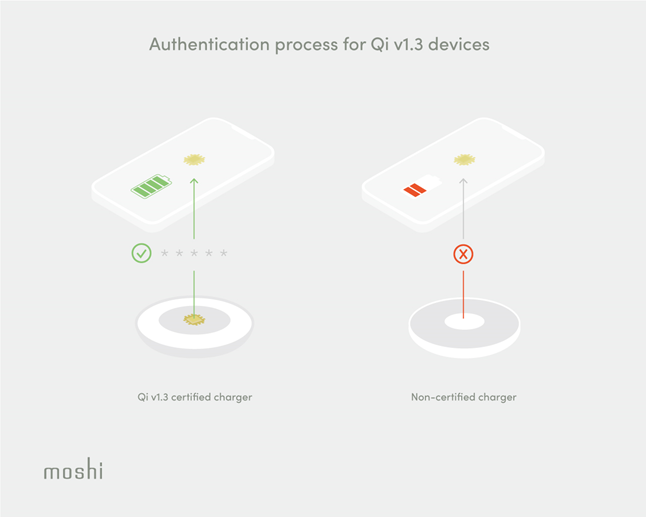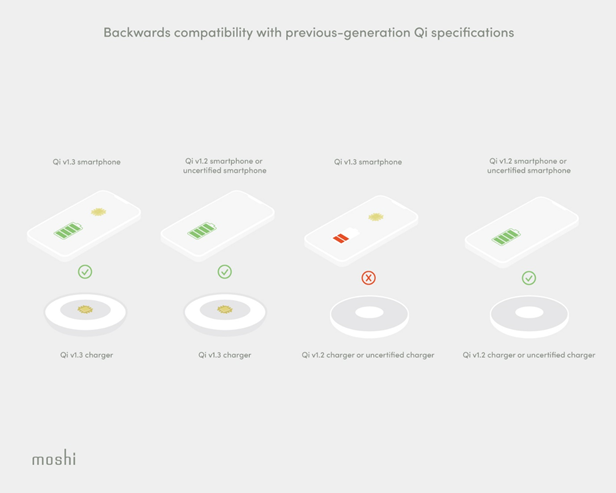자료실
[해외칼럼] Qi v1.3은 무엇이 달라지는가?
- 작성일2022/09/02 10:36
- 조회 342
[번역요약]
Qi v1.3은 가장 유명한 무선충전 산업표준의 업데이트 규격입니다. 2010년 첫 공개 이후, Qi 무선충전 규격은 여러번의 개정으로 출력, 효율, 안전성 등을 개선해왔습니다.
Qi v1.2는 2015년 발표되어, 최대 15W까지의 고속무선충전 기능을 도입되었습니다. 이후 충전 편의성 개선 등 마이너한 개정이 몇차례 있었습니다.
2021년부터 시행되는 Qi v1.3 표준규격은 같은 연장선에서 업데이트 되었습니다. 출력에는 변화는 없지만, 충전패드와 충전단말 간 인증(Authentication) 알고리즘을 추가한 것이 포인트입니다.
이번 포스트에서는 Authentication 알고리즘이 충전 시, 안전성과 충전 편의성을 어떻게 개선하는지 알아보겠습니다.
핵심은 인증된 충전방식
가장 중요한 핵심은, 송신기(충전기)와 수신기(스마트폰 또는 기타 장치) 사이에 인증 프로토콜을 사용하면 수신기가 Qi 인증 송신기와 상호 작용하고 있는지 확인하고 송신기에 가장 적절한 무선 충전 전력을 요청합니다.
기기가 Qi 인증 충전기를 인증할 수 없는 경우, 허용 전력량을 제한하거나 충전이 되지 않도록 거부할 수 있습니다. 이 방법은 암호를 사용하여 허락되지 않은 사용자로부터 홈 WiFi 네트워크를 보호하는 것과 비슷합니다.
가장 중요한 것은 안전
Qi 인증에서 가장 중요시하는 점은 사용 장치와 사용자의 안전입니다.
Qi 인증에는 무선 충전 과정에서 충전기나 수신기가 손상될 위험을 최소화하기 위한 여러 안전한 기능들을 포함하고 있으며, 제조업체는 WPC의 Qi 인증 과정을 통해 장치의 안전 기능이 올바르게 작동하는지 할인할 수 있습니다. Qi 인증을 통과하지 않은 무선 충전기는 안전 기능을 지원하지 않을 수 있으며 수신기의 손상, 사용자의 상해, 또는 화재나 폭발 같은 사고를 초래할 수도 있습니다.
작동 원리
인증이 완료된 송신기와 수신기는 모두 물리적인 인증 칩을 내장하고 있습니다. 그러므로 펌웨어 업데이트만 진행한다면 상위 호환은 불가능합니다. 수신기(스마트폰)를 송신기(충전기)에 내려놓을 때, 근거리 통신 프로토콜을 사용하여 수신기는 송신기에 인증 키를 요청하고, 미리 정의된 알고리즘을 사용하여 송신기의 인증 여부 상태를 확인합니다. 인증이 확인되면 안전한 충전을 위해 수신기로부터 필요한 양의 충전 전력을 요청하게 됩니다. 인증 결과에 따라 충전기에 요청할 충전 전력은 항상 수신기가 결정합니다.
인증 칩의 생산과 공급은 Wireless Power Consortium(WPC) 승인 파트너인 소수 제조사로 제한되며, 다른 제조사가 위조 칩을 만들거나 인증받지 않고 인증받았다고 허위로 주장하는 것은 불가합니다.
하위 버전과의 호환 여부
새로운 인증 프로토콜은 기존 기기에 인증 칩이 없기 때문에 상위 버전과 하위 버전의 호환이 제한됩니다. Qi v1.2를 지원하는 기존 송신기와 수신기를 당장 사용할 수 없는건 아니지만, 사용 중인 장치 조합에 따라 제한 사항이 발생 할 수 있습니다.
- v1.3 충전기 및 v1.3 스마트폰 : 인증 완료 후 최적의 충전 출력을 제공.
- v1.3 충전기 및 v1.2 스마트폰 : 수신기(스마트폰)가 요청할 전력량을 결정하므로, 수신기가 새로운 인증 기능을 지원하지 않을 경우 이전 버전으로 송신기에 전력을 요청.
- v1.2 충전기 및 v1.3 스마트폰 : 각 제조사의 규정에 따라 v1.3 수신기가 v1.2 충전기를 사용할 때 수행 작업을 선택하지만, 알고리즘 인증이 없으면 v1.2으로 인증이 된 송신기인지 인증 안된 송신기를 구별이 불가함.
(인증되지 않은 장치는 충전 전력이 수신기에 의해 제한되거나 완전히 거부될 수 있음)
- v1.2 충전기 및 v1.2 스마트폰 : 이 두 개의 기기를 같이 사용하는 경우 정상적으로 작동함
[칼럼 원문] 작성자: Trent, 출저: https://www.moshi.com/en/blog/what-is-qi-v1-3-and-how-will-it-improve-wireless-charging
Qi v1.3 is set to be the next update to the popular de facto industry standard for wireless charging. The Qi wireless charging specification has seen multiple revisions and modifications since it was first released in 2010, bringing with them improvements in power output, efficiency, and safety. The current Qi specification v1.2 was released in 2015 and brought the possibility of wireless fast-charging up to 15 W, for the first time allowing Qi to realistically compete with wired charging technologies. Minor revisions were made to v1.2 over the years following its release to address minor issues and further improve the wireless charging experience.
Jump forward to 2021 and v1.3 of the Qi specification is on the horizon. While no major increases in charging output are expected, the main focus of the new specification is expected to be the addition of an authentication algorithm between the transmitter and receiver devices. In this post we'll take a deeper look into what an authentication algorithm means for wireless charging, how it's likely to work, and how it can improve charging safety and the Qi experience. If you need a quick refresher on how wireless charging itself works, check out our beginners' guide.
The key to certified charging
On the most basic level, using an authentication protocol between transmitter (charger) and receiver (smartphone or other device) allows the receiver device to confirm that it is interacting with a Qi-certified transmitter and request an appropriate and safe level of wireless charging power from the charger. In the case that the device is unable to authenticate a Qi-certified charger, it could choose to limit the amount of power it accepts or reject charging altogether. This could be thought of a similar to how you use a password to protect your home WiFi network from unauthorized users, only allowing those who are able to pass authentication (and that you trust) gain access to the network.
Safety first
While at first glance the implementation of device authentication may appear an effort to force manufacturers to certify devices (and consumers to purchase certified products), the primary intention behind such an implementation is the safety of consumers and their devices. Built in to the Qi certification are a number of safety features intended to minimize the risk of damage to either charger or receiver during the wireless charging process. Only by passing the WPC's Qi certification process can a manufacturer be sure that their device's safety features work correctly. Wireless chargers which have not passed Qi certification may not support or comply with important safety features and could cause permanent damage to receiver devices, harm to users, or dangerous incidents such as fire or explosions.
How does it work?
The authentication process will rely on physical chipsets integrated into both certified transmitters and receivers, meaning that it won't be possible to achieve forward compatibility with a firmware update. When a receiver device detects the presence of a transmitter nearby (such as when placed down on a charger), it will use a short-range communication protocol to request a certification key from the transmitter, and use a pre-defined algorithm to determine the certification status of the transmitter device. Once authenticated, the receiver will then request the desired amount of charging power from the receiver to ensure safe charging. The onus will always be on the receiver to determine how much charging power it will request from the charger based on the results of authentication.
Production and supply of these specialized authentication chips will be limited to a small number of manufacturers who are approved partners of the Wireless Power Consortium (WPC), making it difficult for manufacturers to make counterfeit chips or falsely claim that their products are certified.

Will it be backward compatible?
Due to the fact that the new authentication protocol will use physical components which are not present in current devices, there will be limited backward compatibility between the new and old specifications. Existing transmitters (chargers) and receivers (smartphones and other devices) supporting the current Qi specification (v1.2) will not become obsolete overnight, but may encounter some limitations in the future based on the combination of devices being used:
- v1.3 charger and v1.3 smartphone - Optimal charging output will be provided following successful authentication.
- v1.3 charger and v1.2 smartphone - As the receiver (usually a smartphone) makes the determination as to how much power to request, if the receiver does not support the new authentication feature, it will continue to request power from the transmitter according to the older specification.
- v1.2 charger and v1.3 smartphone - Based on each manufacturer's stipulation, a v1.3 receiver will be able to choose what to do when it encounters a previous-generation charger. However in the absence of algorithmic authentication, it will be unable to discern a previous generation certified transmitter from a non-certified one. This could mean that charging power may be limited or totally rejected by the receiver depending on the manufacturer's policy for un-authenticated devices.
- v1.2 charger and v1.2 smartphone - These devices will continue to operate as normal when used together.








